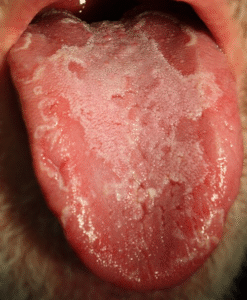Geographic tongue, also known as benign migratory glossitis, is a harmless condition where the top and sides of the tongue develop smooth, red patches with white or gray borders. These irregular “map-like” patterns migrate over time—disappearing in one spot only to reappear in another. It’s noncancerous and typically doesn’t require treatment, though it can cause discomfort for some.
How Common Is It and Who Gets It?
This condition affects about 2–3% of people worldwide, more often seen in young to middle-aged adults, and slightly more common in women. It may run in families and is sometimes linked to fissured tongue, psoriasis, eczema, type 1 diabetes, and nutritional deficiencies.
Why Is It Called “Geographic Tongue?
The term “geographic tongue” comes from the map-like appearance of the tongue’s surface. The condition is characterized by irregular, smooth red patches that are bordered by slightly raised white or yellow edges. These patches often change shape, size, and location over time—much like shifting continents on a map. Because of this migratory behavior and the visual resemblance to geographic patterns, the name “geographic tongue” was adopted. Clinically, it is also known as benign migratory glossitis, highlighting its non-cancerous nature and the migratory aspect of the lesions.
What Does It Look and Feel Like?
On close inspection, geographic tongue shows smooth patches on the tongue where the tiny papillae are missing. These red lesions are often outlined with white borders, giving a striking map-like appearance. Symptoms vary—many people don’t experience pain, but others report burning or tingling, especially after spicy or acidic foods.
What Causes It?
The exact cause of geographic tongue remains unclear, but several contributing factors have been consistently observed in medical literature and clinical practice. One of the most commonly proposed causes is a genetic predisposition. This means if someone in your family has had geographic tongue or a related condition like fissured tongue, you may be more likely to develop it as well. In many cases, this condition tends to run in families and is observed alongside other inherited traits.
Geographic tongue has also been linked to systemic and autoimmune disorders. Individuals with conditions like psoriasis, allergic rhinitis, type 1 diabetes, and even celiac disease have shown a higher prevalence of geographic tongue. These connections suggest that immune dysregulation plays a role in the inflammation and desquamation (shedding) of tongue tissue. The condition has also been associated with nutritional deficiencies, particularly in iron, folic acid, zinc, and B vitamins, all of which are essential for maintaining healthy mucosal tissues in the mouth.
Environmental and lifestyle factors can trigger or exacerbate the symptoms. Spicy, acidic, or salty foods are common irritants, as are alcohol and tobacco. These substances can inflame already sensitive areas on the tongue and contribute to recurring flare-ups. Stress and hormonal fluctuations are also believed to contribute, particularly in women who report changes during menstruation or pregnancy.
Despite these associations, no single cause has been definitively established. Most experts agree that geographic tongue is multifactorial—meaning it’s the result of a combination of genetic, immunological, nutritional, and environmental influences. The good news is that even though the exact cause is elusive, the condition is not dangerous, and most people experience only mild symptoms or none at all.
Geographic Tongue Pictures
How Is Geographic Tongue Diagnosed?
Diagnosis is straightforward and entirely clinical. A dentist or doctor will inspect the tongue and review your medical history. In most cases, no tests are necessary, though your provider may want to rule out other conditions like oral lichen planus or candidiasis.
Diagnosis is typically made through clinical examination. Because of its characteristic appearance—migrating, erythematous patches with a white border—most healthcare providers can confidently diagnose geographic tongue without further testing. Biopsy is only considered if symptoms are unusual or persistent. For symptomatic patients, management strategies may include topical corticosteroids, antihistamine mouthwashes, or anesthetic gels to reduce discomfort. However, many individuals do not require treatment at all.
Broader Connections and Evolving Insights
Recent literature and clinical reviews reveal that some natural remedies for toothache relief may also intersect with broader oral health conditions—such as geographic tongue—and emerging systemic influences. While these findings don’t directly validate each remedy as a treatment for tooth pain, they offer important context for patients exploring integrative or holistic oral care.
Nutritional Deficiencies and Oral Pain Sensitivity
Many of the ingredients discussed—such as garlic, aloe vera, and turmeric—are rich in compounds that influence systemic inflammation and immune responses. Studies have shown that deficiencies in vitamin B12, folate, zinc, and iron not only predispose individuals to oral mucosal disorders like geographic tongue, but may also amplify sensitivity to pain. These deficiencies are frequently present in individuals reporting chronic or recurring oral discomfort, suggesting a potential overlap in mechanisms driving both toothache and oral surface irritation.
Co-Conditions and Oral Mucosal Health
Conditions such as geographic tongue—while typically benign—are increasingly associated with broader systemic patterns including psoriasis, celiac disease, Down syndrome, and reactive arthritis. Though not direct causes of toothache, these conditions may create underlying inflammation in the mouth or alter pain thresholds, making natural anti-inflammatory agents (like curcumin or allicin) more relevant as adjunctive relief strategies.
Additionally, natural remedies such as clove oil and tea tree oil, known for their antimicrobial activity, may help maintain oral microbial balance in patients prone to inflammatory lesions or secondary infections related to mucosal disorders.
Psychological and Hormonal Influences
Several natural agents in your article (e.g., peppermint and turmeric) are also studied for their effects on stress modulation and hormonal balance—two factors increasingly linked with oral pain and flare-ups of inflammatory conditions. For example, anecdotal and observational data suggest that stress, menstrual changes, or oral contraceptive use may worsen both dental pain and mucosal inflammation. This highlights the potential dual benefit of natural remedies that can both numb pain locally and influence systemic pathways related to discomfort.
Ectopic Manifestations and Complex Diagnoses
Lastly, it’s important to recognize that some oral symptoms—such as burning pain, irritation, or shifting lesions—may not stem from a dental origin. Migratory stomatitis, for example, presents with lesions outside the tongue (e.g., lips, cheeks, or palate) and can mimic symptoms of dental infection. This reinforces the need for a thorough diagnosis before relying on home remedies, even natural ones.
When to See a Professional for Geographic Tongue
While geographic tongue is typically a benign and self-limiting condition, it’s important to be aware of symptoms that could signal the need for professional care. Persistent or severe cases may mimic or mask more serious oral conditions. According to trusted sources like the Mayo Clinic and ADA guidelines, you should seek evaluation from a dentist, primary care physician, or oral medicine specialist if certain red-flag symptoms arise.
If the tongue lesions persist for more than two to three weeks without signs of healing or improvement, it’s advisable to consult a healthcare provider. Lingering discomfort, especially burning, pain, or heightened sensitivity that interferes with everyday activities like eating or speaking, should not be ignored. These symptoms may require medical intervention or prescription treatment.
You should also seek professional evaluation if lesions begin appearing on other parts of the mouth—such as the cheeks or gums—as this may suggest other conditions, including oral lichen planus or candidiasis. Additionally, rapid changes in the tongue’s appearance or the presence of other systemic symptoms like fever, fatigue, or swollen lymph nodes could point to a more serious underlying cause that warrants further investigation.
Individuals with a personal or family history of autoimmune diseases or chronic inflammatory conditions such as psoriasis may experience more persistent or severe forms of geographic tongue. In these cases, a specialist may conduct a differential diagnosis to rule out conditions such as leukoplakia, oral cancers, or fungal infections. This process may involve a clinical examination, swab cultures, or even a biopsy if the lesions appear atypical or concerning. Early evaluation and management can help prevent complications and provide symptom relief.
Key Points
- Persistent lesions, pain, or systemic symptoms require professional evaluation.
- Differential diagnosis is essential to rule out other oral or systemic conditions.
- Individuals with autoimmune or inflammatory disorders may experience more severe symptoms.
- A biopsy or culture may be needed in atypical or prolonged cases.
Treatment and Symptom Management for Geographic Tongue
Although there is no cure for geographic tongue, a variety of treatment options can help reduce discomfort and control flare-ups. In most cases, treatment is only necessary for symptomatic individuals. Understanding the available options can help patients manage their condition effectively.
Topical medications are commonly recommended for managing inflammation and sensitivity. Corticosteroid gels or pastes, such as triamcinolone acetonide dental paste, can be applied directly to the affected areas two to three times per day to reduce redness and irritation. For immediate pain relief, topical anesthetics like lidocaine viscous gel can numb the surface temporarily, especially before meals or oral hygiene routines. Antihistamine rinses, such as diluted diphenhydramine (Benadryl), may also be used to ease discomfort when swished in the mouth for 30 to 60 seconds.
Over-the-counter mouth rinses can offer additional support. Alcohol-free formulas are preferred, especially those containing ingredients like cetylpyridinium chloride or aloe vera, which are gentle on irritated tissues. Harsh antiseptics such as chlorhexidine should be avoided unless specifically prescribed by a dentist. Warm saltwater rinses are a simple yet effective option—just dissolve half a teaspoon of salt in one cup of warm water and rinse up to three times daily to reduce inflammation and bacterial load.
Dietary changes play a major role in minimizing flare-ups. Patients are encouraged to avoid known trigger foods, which often include spicy or acidic dishes, citrus fruits, tomatoes, chocolate, and salty snacks. Reducing or eliminating alcohol and tobacco use can also significantly improve symptoms. Drinking plenty of water throughout the day helps maintain a moist oral environment, which can reduce burning sensations.
Oral hygiene habits should also be adjusted for comfort. Using a soft-bristled toothbrush can prevent further irritation, and patients should opt for toothpaste that is free from sodium lauryl sulfate (SLS), a common foaming agent that can exacerbate tongue sensitivity. Patients may also benefit from tracking their symptoms to identify patterns or specific triggers, such as hormonal changes, stress, or dietary habits.
Although geographic tongue is not dangerous, it can be uncomfortable and affect quality of life. With the right combination of topical relief, hygiene adjustments, and dietary awareness, most individuals can effectively manage their symptoms. However, persistent or worsening symptoms should always be discussed with a healthcare provider for appropriate evaluation and support.
Key Points
- Symptom management includes topical steroids, anesthetics, and antihistamine rinses.
- Alcohol-free mouthwashes and saltwater rinses offer gentle, effective relief.
- Identifying and avoiding dietary and lifestyle triggers can reduce flare-ups.
- Good oral hygiene and hydration support comfort and healing.
- Consultation with a healthcare provider is essential if symptoms persist or worsen.
Managing Discomfort and Living with It
While benign, geographic tongue can be uncomfortable. Here’s how to manage it:
- Avoid irritants like spicy, acidic, or very salty foods and tobacco
- Practice gentle oral hygiene using a soft toothbrush and alcohol-free toothpaste
- Stay hydrated and maintain a balanced diet rich in vitamins and minerals
- Consider supplements like B-complex vitamins or zinc if you’re deficient (after consulting your doctor)
Most symptoms resolve on their own, but you can ease occasional flares through simple care.
Despite its alarming appearance, geographic tongue does not predispose you to oral cancer or serious disease. There’s no risk of contagion or spreading to others. It’s considered a chronic, benign condition. Geographic tongue is a noncancerous, often painless condition that causes shifting red patches on the tongue. It affects a small proportion of the population and may be triggered by genetics, allergies, or dietary factors. While it doesn’t require aggressive treatment, discomfort can be managed with mouth rinses and simple lifestyle adjustments. If lesions persist beyond two weeks or cause major symptoms, consult your dentist or doctor for proper assessment and reassurance.
Keep reading: How Do Night Guards Work?






